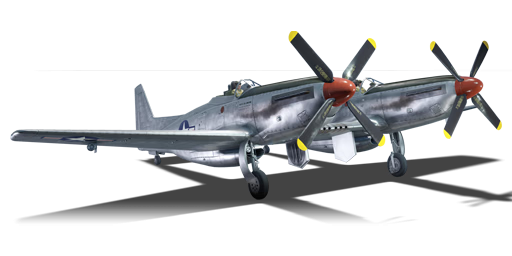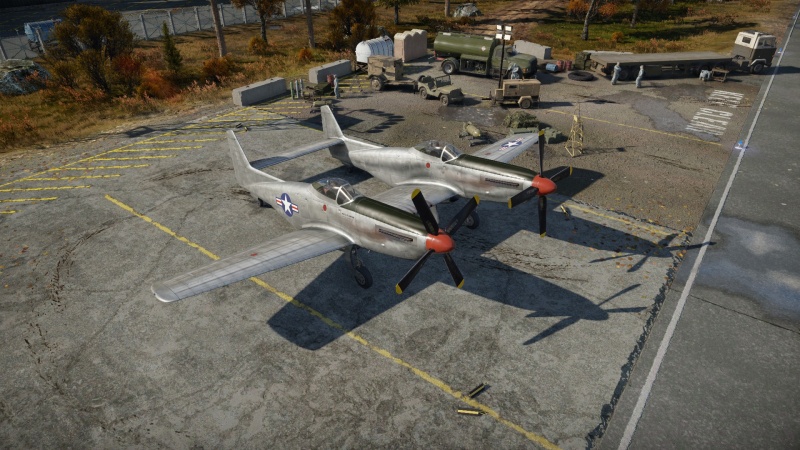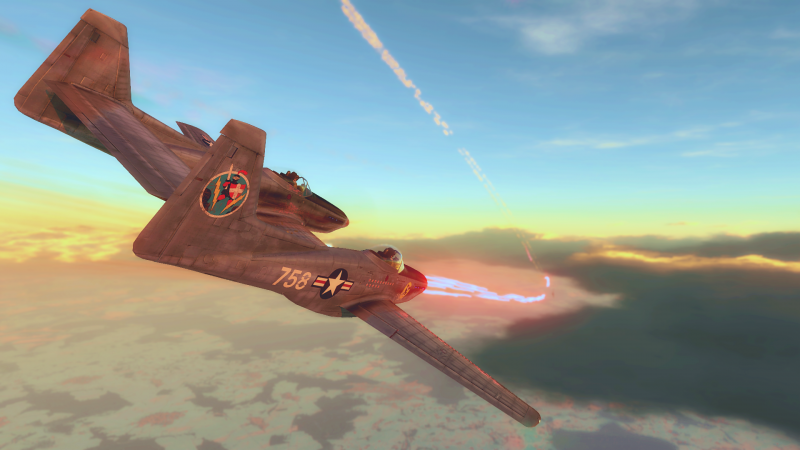Difference between revisions of "F-82E"
Colok76286 (talk | contribs) (Edits) |
|||
| (3 intermediate revisions by 3 users not shown) | |||
| Line 1: | Line 1: | ||
| − | |||
| − | |||
| − | |||
| − | |||
| − | |||
{{Specs-Card | {{Specs-Card | ||
|code=f-82e | |code=f-82e | ||
| − | |images={{Specs-Card-Image|GarageImage_{{PAGENAME}}.jpg}} | + | |images={{Specs-Card-Image|GarageImage_{{PAGENAME}}.jpg|ArtImage_{{PAGENAME}}.png}} |
|cockpit=cockpit_f-82e.jpg | |cockpit=cockpit_f-82e.jpg | ||
}} | }} | ||
| Line 113: | Line 108: | ||
* Without load | * Without load | ||
| − | * | + | * 4 x 500 lb AN-M64A1 bombs (2,000 lb total) |
* 2 x 1,000 lb AN-M65A1 bombs (2,000 lb total) | * 2 x 1,000 lb AN-M65A1 bombs (2,000 lb total) | ||
* 2 x 2,000 lb AN-M66A2 bombs (4,000 lb total) | * 2 x 2,000 lb AN-M66A2 bombs (4,000 lb total) | ||
| − | * | + | * 25 x HVAR rockets |
* 8 x 12.7 mm M2 Browning machine guns, centre-mounted (gunpod) (400 rpg = 3,200 total) | * 8 x 12.7 mm M2 Browning machine guns, centre-mounted (gunpod) (400 rpg = 3,200 total) | ||
| Line 202: | Line 197: | ||
* ''links to approximate analogues of other nations and research trees.'' --> | * ''links to approximate analogues of other nations and research trees.'' --> | ||
| + | ;Related development | ||
| + | * [[P-51 (Family)]] | ||
| + | ** [[P-51H-5-NA]] | ||
;Aircraft of comparable role, configuration and era | ;Aircraft of comparable role, configuration and era | ||
Latest revision as of 18:05, 21 December 2023
Contents
Description
To combat the issue of single-pilot fighters flying long combat missions, the United States Army Air Force (USAAF) proposed a two-seat, double-engine version of the Mustang. The idea was proposed in 1943 and one year later the USAAF ordered two XP-82s. The XP-82 was essentially two P-51H fuselages fused together. The first two prototypes had the standard Packard Merlin engine which produced 1,860 hp. However, concerns grew with Packard's ability to produce more Merlin engines and the Allison engine had developed into a decent powerplant. This was compounded by the fact that Rolls-Royce was significantly increasing the price of the Merlin engine. By this time, the Allison engines could perform sufficiently at high altitudes and could produce almost 2,000 horsepower at sea level thanks to the water-methanol injection system. Around 96 F-82Es were delivered with the Allison V-1710-143/145 engines.
Introduced in Update 1.39, the F-82E Twin Mustang is an iconic aircraft that lives up to expectations. It's extremely fast with a top speed of 742 km/h (463 mph) and a high structural limit of 854 km/h (531 mph). The F-82E was intended to escort the B-29 and thus was fitted with six M3 Browning machine guns mounted in the center of the airframe. An additional gunpod can be mounted in the center which provides an additional eight M2 Browning machine guns. The gunpod is quite draggy and for optimal performance shouldn't be used. For ground attacking though, the gunpod is an excellent option due to its ample ammunition pool. The F-82E can also carry bombs and rockets.
General info
Flight performance
The F-82E is a relatively sleek aircraft powered by two Allison V-1710 engines. With water injection, the engines can produce a whopping 1,960 hp at sea level which can easily outrun many fighters at its BR. The F-82E also has a hydraulic boost system for the control surfaces which allows the F-82E to have an excellent roll rate. However, it's still a twin-engine aircraft and turning is quite lacklustre. The F-82E excels in boom and zoom tactics thanks to its favourable high-speed flight characteristics.
| Characteristics | Max Speed (km/h at 6,126 m) |
Max altitude (metres) |
Turn time (seconds) |
Rate of climb (metres/second) |
Take-off run (metres) | |||
|---|---|---|---|---|---|---|---|---|
| AB | RB | AB | RB | AB | RB | |||
| Stock | 713 | 696 | 11600 | 28.3 | 28.7 | 15.3 | 15.3 | 450 |
| Upgraded | 770 | 742 | 25.8 | 27.0 | 26.4 | 18.7 | ||
Details
| Features | ||||
|---|---|---|---|---|
| Combat flaps | Take-off flaps | Landing flaps | Air brakes | Arrestor gear |
| ✓ | ✓ | ✓ | X | X |
| Limits | ||||||
|---|---|---|---|---|---|---|
| Wings (km/h) | Gear (km/h) | Flaps (km/h) | Max Static G | |||
| Combat | Take-off | Landing | + | - | ||
| 854 | 314 | 650 | 520 | 265 | ~11 | ~11 |
| Optimal velocities (km/h) | |||
|---|---|---|---|
| Ailerons | Rudder | Elevators | Radiator |
| < 500 | < 700 | < 700 | > 450 |
Survivability and armour
The Twin Mustang has nearly two of everything: two fuselages, two engines, two tails, and two pilots. The last of which makes the Twin Mustang more survivable than most other fighter aircraft as each can work independently if the other is incapacitated.
Built with the intended purpose as a long-range escort for B-29 Superfortress heavy bombers, the fuel capacity in the Twin Mustang is much higher than its contemporaries. This means you will almost never run out of fuel, but you may also burn longer if the fuel tanks are ignited by enemy fire.
- 38 mm Bulletproof glass - Windshield
- 6.35 mm Steel - Fore cockpit armour plate, pilot and co-pilot
- 8 mm Steel - Armour plate, pilot and co-pilot's seats
- 11 mm Steel - Armour plate headrests, pilot and co-pilot
- 19.05 mm Steel - Engine protective plate
Modifications and economy
Armaments
Offensive armament
The F-82E is armed with:
- 6 x 12.7 mm M3 Browning machine guns, centre-mounted (400 rpg = 2,400 total)
Unlike the preceding American aircraft, the Twin Mustang no longer features outer wing-mounted armament but instead are now centre-mounted between the fuselages, so gun convergence is not a huge issue. When using tracer bullets and shooting continuously, it is possible to adjust aim effectively from more than 1.5 km away. In head-ons, this means your opponent will usually be destroyed or crippled well before he gets his own target indicator. With bombers, it means one serious burst from 0.7-1.0 km will deliver a critical, and a full-second burst from less than 0.7 km should cut any bomber into several pieces.
Suspended armament
The F-82E can be outfitted with the following ordnance:
- Without load
- 4 x 500 lb AN-M64A1 bombs (2,000 lb total)
- 2 x 1,000 lb AN-M65A1 bombs (2,000 lb total)
- 2 x 2,000 lb AN-M66A2 bombs (4,000 lb total)
- 25 x HVAR rockets
- 8 x 12.7 mm M2 Browning machine guns, centre-mounted (gunpod) (400 rpg = 3,200 total)
While its respectable payload of bombs, machine guns, and rockets make it an effective ground attacker, it is very vulnerable in that role unless all the enemy's fighters have all been neutralized.
Usage in battles
Start play by climbing above 5,000 m while always maintaining a speed above 290 km/h. If this brings you in range of enemy fighters before you have achieved a height advantage simply turn away and let them seek other targets. Once you have achieved 5,000 m altitude with airspeed above 300 km/h you are virtually invulnerable since you will always have the option of running away with or without diving. You can seek and destroy bombers. Any fighter foolish enough to go after you should be dealt with head-on starting from more than 1.2 km away to ensure time to adjust and kill with your machine guns. If this is not an option or if you are being engaged by a pair of fighters, or if your initial pass fails to kill, keep running. Very few planes can follow you and your frame is sturdy enough to withstand the occasional long-distance hit.
As a rule, never let your airspeed drop below 300 km/h; do not go near ground level if there is more than one enemy fighter in the vicinity unless your airspeed is above 500 km/h, and never engage in furballs.
When used as a heavy fighter, keep in mind the brutally low handling capability of the F-82. Always avoid "furballs" and stay above your opponents. The climb rate makes the F-82 a capable bomber-killer. As a bomber killer, the aiming problems that many pilots face against smaller, more agile fighters evaporate. It is recommended to utilize the 8 x M2 gunpods, due to the extremely high damage output. However, more experienced players may do away with this option, as it does hamper the handling of the craft.
Due to its high speed, it is very dangerous when used in a boom-and-run strategy (energy retention and a very high top speed in level flight mean it can be untouchable for a lot of single-engine fighters). In this case, it's very important to watch one's speed and to throttle back in dives or it can lose its wings due to high speed. For achieving the maximum straight-line speed at sea level, one should have the engine mixture set to 72%.
Remember, do not attempt to engage smaller and nimbler fighters, as most of the time you will overshoot and completely miss due to poor handling.
Always use the tracer bullets with your six or fourteen 12.7 mm machine guns. Not only are the tracers very effective incendiaries, but they also give you the ability to see exactly where you are shooting up to 2 km away. This is invaluable in destroying bombers from far enough away to avoid their tail gunners, and in achieving incredible accuracy in head-ons well before your enemy gets a target indicator on you.
Boom and Zoom is not an ideal strategy with the F-82. At about 650 km/h you will experience extreme control stiffening. The F-82 excels in the destruction of bombers and other aircraft in head-ons.
Manual Engine Control
| MEC elements | ||||||
|---|---|---|---|---|---|---|
| Mixer | Pitch | Radiator | Supercharger | Turbocharger | ||
| Oil | Water | Type | ||||
| Not controllable | Controllable Auto control available |
Not controllable Not auto controlled |
Controllable Auto control available |
Combined | Not controllable 2 gears |
Not controllable |
Pros and cons
Pros:
- Variety of payload options
- Good fast-firing armament (M3 Browning MGs) with a high ammo capacity
- Above average climb rate
- Fast once upgraded (can outrun pretty much every fighter in level flight)
- Excellent in head-ons (which should rather be avoided due to large profile of F-82)
- M20 API-T ammunition option
- When equipped with a gunpod the F-82 is a flying flamethrower
- Brutal acceleration in dive
- Centre-mounted armament both primary and gunpod, allowing for devastating accuracy
- Pilot and co-pilot seated offset from the centre of the aircraft, making them harder to reliably hit, especially in a head-on engagement
- Sturdy airframe
Cons:
- Poor handling
- Poor turn rate
- Difficult to aim (it gets a bit better with booster upgrade)
- Elevator prone to failure when damaged
- With the gunpod installed, the continuous fire will slow the plane down significantly
- Prone to control stiffening in a dive
History
Designed to provide the US forces with long-range escort capabilities over the Pacific, the F-82 bore the appearance of desperate measures taken to use surplus P-51 parts. In reality, the F-82 was purposely designed as such in order to provide a fighter plane that had fresh pilots ready to engage, despite the tedious nature of long distance flights. Each fuselage carried a pilot and a co-pilot/navigator which reduced individual fatigue over long missions.
The F-82 started development in 1944, with significant deliveries done in early 1946. Although too late for the war, the fighter still saw extensive use by Air Defense Command as an escort fighter and a night fighter. 14 F-82's were converted to winterized interceptors for use over Alaska. It also saw significant use in the Korean War with Japanese based (US planes deployed from Japan) F-82s among the first aircraft to operate over Korea. In fact, the first three North Korean aircraft shot down by US forces were done so by the Twin Mustang.
Media
- Skins
- Videos
See also
- Related development
- Aircraft of comparable role, configuration and era
External links
| North American Aviation | |
|---|---|
| Fighters | |
| P-51A | P-51 · P-51A |
| P-51C | P-51C-10 |
| P-51D | P-51D-5 · P-51D-10 · P-51D-20-NA · P-51D-30 |
| P-51H | P-51H-5-NA |
| Twin-engine fighters | F-82E |
| Jet fighters | F-86A-5 · F-86F-2 · F-86F-25 · F-86F-35 · F-100D |
| Strike aircraft | A-36 · PBJ-1H · PBJ-1J |
| FJ-4B · FJ-4B VMF-232 | |
| Bombers | B-25J-1 · B-25J-20 |
| Export/Licence | ▂B-25J-30 · ␗B-25J-30 |
| ▄Mustang Mk IA · F-6C-10-NA · ␗P-51C-11-NT · ␗P-51D-20 · J26 David · J26 · P-51D-20-NA · ␗P-51K | |
| F-86F-30 ▅ · ␗F-86F-30 · F-86F-40 ▅ · F-86F-40 JASDF▅ · ␗F-86F-40 | |
| ◄F-86K · ▄F-86K (Italy) · ▄F-86K (France) | |
| ␗F-100A · ▄F-100D · ␗F-100F | |
| Captured | ▅P-51C-11-NT |
| Canadair Limited license-built the F-86 as the CL-13 for use in Canada and export to Europe. | |
| Fiat license-built the F-86K for the Italian Air Force though another 120 NAA built F-86Ks were also sold to the Italians. | |
| See Also | Mitsubishi Heavy Industries · Canadair Limited · Fiat Aviation |
| USA twin-engine fighters | |
|---|---|
| P-38 | XP-38G · P-38E · P-38G-1 · P-38J-15 · Bong's P-38J-15 · P-38L-5-LO · P-38K · YP-38 |
| P-61 | P-61A-11 · P-61C-1 |
| F7F | F7F-1 · F7F-3 |
| Other | XF5F · XP-50 · F-82E |






